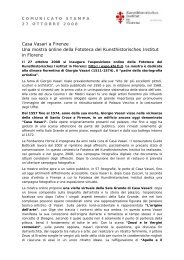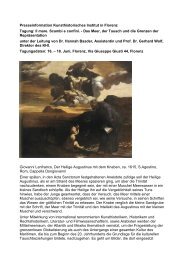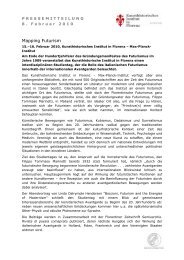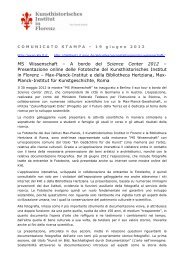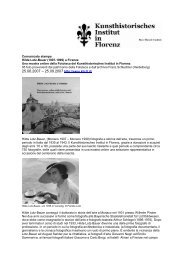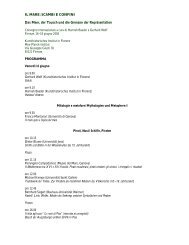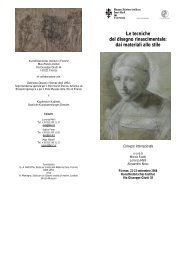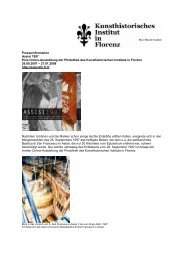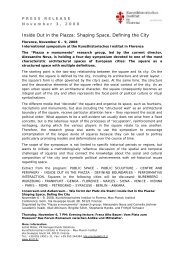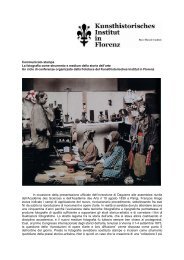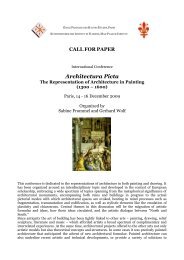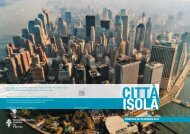Photo Archives and the Photographic Memory of Art
Photo Archives and the Photographic Memory of Art
Photo Archives and the Photographic Memory of Art
You also want an ePaper? Increase the reach of your titles
YUMPU automatically turns print PDFs into web optimized ePapers that Google loves.
PRESS RELEASE<br />
19th October, 2009<br />
<strong>Photo</strong> <strong>Archives</strong> <strong>and</strong> <strong>the</strong> <strong>Photo</strong>graphic <strong>Memory</strong> <strong>of</strong> <strong>Art</strong> History,<br />
Part II<br />
29 th –31 st October 2009, Kunsthistorisches Institut in Florenz – Max-Planck-<br />
Institut<br />
An International conference on <strong>the</strong> connection between photography <strong>and</strong> <strong>the</strong><br />
history <strong>of</strong> art in collaboration with <strong>the</strong> Courtauld Institute <strong>of</strong> <strong>Art</strong>, London<br />
While <strong>the</strong> first part <strong>of</strong> <strong>the</strong> conference in London traced <strong>the</strong> parallel developments <strong>of</strong> art<br />
historical research <strong>and</strong> documentary photography, <strong>the</strong> scholars in Florence now shift <strong>the</strong><br />
focus to <strong>the</strong> emergence <strong>and</strong> development phases <strong>of</strong> individual photographic collections<br />
<strong>and</strong> archives.<br />
The discussion begins by considering <strong>the</strong> materiality <strong>of</strong> <strong>the</strong> photographic document,<br />
which, taking into account all <strong>the</strong> subordinate information <strong>and</strong> meta-data surrounding it,<br />
is analysed from different perspectives: as <strong>the</strong> reproduction <strong>of</strong> an object or artwork, but<br />
also as an archival document or <strong>the</strong> object <strong>of</strong> inquiry itself. In this context <strong>the</strong><br />
consideration <strong>of</strong> <strong>the</strong> archive as a whole is essential, not only as a site for <strong>the</strong><br />
conservation <strong>of</strong> knowledge, but also its production.<br />
In <strong>the</strong> process, particular attention will be devoted to collections <strong>of</strong> photographic<br />
reproductions <strong>of</strong> art, which developed in direct relationship to art historical research.<br />
Different types <strong>of</strong> photographic archives – private photographic collections, resource<br />
collections for museums, photographic archives for <strong>the</strong> preservation <strong>of</strong> historical<br />
monuments, or those dedicated to university instruction – will be analyzed according to<br />
<strong>the</strong> circumstances <strong>of</strong> <strong>the</strong>ir development <strong>and</strong> <strong>the</strong>ir specific impact. Such collections include<br />
that <strong>of</strong> Richard Hamann, conceived as an “art historical world archive”, <strong>the</strong> Bildarchiv<br />
<strong>Photo</strong> Marburg, or <strong>the</strong> collections <strong>of</strong> major scholars <strong>and</strong> art historians such as Jacob<br />
Burckhardt <strong>and</strong> Bernard Berenson. By way <strong>of</strong> example, <strong>the</strong> conference will pursue <strong>the</strong><br />
historical formation <strong>of</strong> <strong>the</strong> photographic collection <strong>of</strong> <strong>the</strong> South Kensington Museum<br />
(presently <strong>the</strong> Victoria & Albert Museum in London), or <strong>the</strong> private collection <strong>of</strong> <strong>the</strong><br />
American photographer, art lover <strong>and</strong> art historian Clarence Kennedy.<br />
Finally, several lectures will focus on <strong>the</strong> present <strong>and</strong> future <strong>of</strong> photographic archives,<br />
whose functions have, to a significant extent, changed through <strong>the</strong> implementation <strong>of</strong><br />
new media. Consequently, <strong>the</strong> debate on analogue <strong>and</strong> digital photographic archives will<br />
be discussed in depth during a concluding round table. The discussion will start with <strong>the</strong><br />
recognition <strong>of</strong> <strong>the</strong> importance <strong>of</strong> analogue photographic archives as a research<br />
environment not only for art history, but also <strong>the</strong> wider academic field including<br />
disciplines such as history, <strong>the</strong> history <strong>of</strong> science, <strong>the</strong> history <strong>of</strong> photography,<br />
anthropology <strong>and</strong> visual studies.
<strong>Photo</strong> <strong>Archives</strong> <strong>and</strong> <strong>the</strong> <strong>Photo</strong>graphic <strong>Memory</strong> <strong>of</strong> <strong>Art</strong> History, Part II<br />
29 th –31 st October, 2009<br />
Kunsthistorisches Institut in Florenz – Max-Planck-Institut<br />
Conference room, Via Giuseppe Giusti 38, 50121 Firenze<br />
Organisers: Costanza Caraffa (Kunsthistorisches Institut in Florenz – MPI) in collaboration with<br />
Patricia Rubin (Institute <strong>of</strong> Fine <strong>Art</strong>s, New York)<br />
“<strong>Photo</strong> <strong>Archives</strong> <strong>and</strong> <strong>the</strong> <strong>Photo</strong>graphic <strong>Memory</strong> <strong>of</strong> <strong>Art</strong> History, Part I” was held on 16 th /17 th June,<br />
2009 at <strong>the</strong> Courtauld Institute <strong>of</strong> <strong>Art</strong>, London.<br />
For fur<strong>the</strong>r information:<br />
Astrid Müller<br />
Public Relations<br />
Kunsthistorisches Institut in Florenz – Max-Planck-Institut<br />
Via Giuseppe Giusti 44, 50121 Firenze<br />
Tel.: +39 055 24911–1, Fax: +39 055 244394<br />
khi-presse@khi.fi.it, www.khi.fi.it/<br />
PRESS RELEASE, 19th October 2009<br />
<strong>Photo</strong> <strong>Archives</strong> <strong>and</strong> <strong>the</strong> <strong>Photo</strong>graphic <strong>Memory</strong> <strong>of</strong> <strong>Art</strong> History, Part II<br />
29th–31st October, 2009<br />
Kunsthistorisches Institut in Florenz – Max-Planck-Institut



